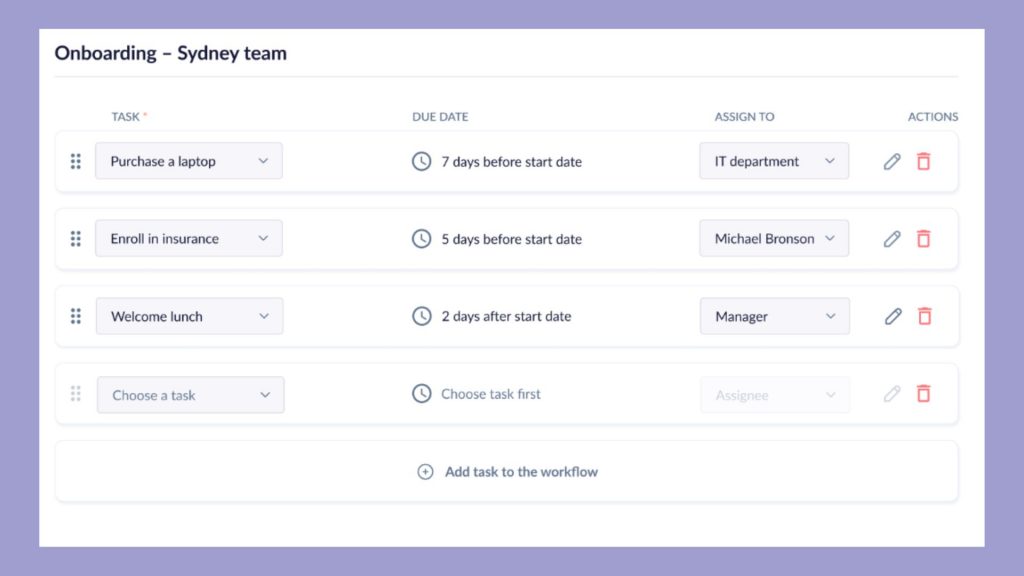- Benefits of Remote Onboarding
-
9 Effective Tips for Onboarding Remote Employees
- 1. Send a warm welcome
- 2. Give remote workers the tools they need to complete their duties
- 3. Encourage a supportive team culture
- 4. Provide a clear organizational structure
- 5. Share your remote work policy
- 6. Provide ample training
- 7. Maintain a channel of open communication
- 8. Gather employee feedback
- 9. Utilize remote onboarding checklists
- Build Effective Remote Onboarding Programs with Omni
It’s become increasingly clear that remote work is here to stay. According to Buffer’s State of Remote Work 2023 71% of companies are permanently allowing some amount of remote work for their teams. Which means remote onboarding has become a permanent reality for HR teams supporting remote employees.
Since they can’t stroll down the hall to a coworker’s desk to ask a question, remote employees have unique demands that may differ from office workers and require technologies to facilitate communication, this also holds true for their onboarding. Onboarding is a critical part of building an engaged workforce, and onboarding remote employees requires a unique set of tools, technologies, and resources to adequately set them up for success.
Benefits of Remote Onboarding
Streamlined processes
Prior to remote work becoming the norm among many companies, Human Resource teams didn’t have a separate onboarding process for remote employees. There may have been unique instances where accommodations were made for remote employees, but there wasn’t clear value in building a remote onboarding process.
The switch to remote work allows for the opportunity to reimagine the onboarding process; one that’s built with remote employees top of mind. This is done through leveraging technology that allows for automation and eliminating older tools or processes that require too many manual processes. When utilizing HR automation tools such as Omni, HR teams can set up streamlined workflows and automatic reminders to provide employees with a cohesive and consistent onboarding experience that breeds engagement and boosts productivity.
Increased productivity
With lengthy commutes and stuffy conference rooms becoming a thing of the past, remote work has helped usher organizations into a more modern and productive workplace. Because remote onboarding takes place digitally, employees can access the materials they need from anywhere, at any time, allowing them to complete their onboarding at a time that is most convenient for their schedule and at their own pace. This alleviates HR of the need to host multiple onboarding sessions to accommodate competing schedules or spend hours creating hard copy documents. Remote onboarding allows HR teams to easily and quickly distribute materials, and empowers employees to learn to navigate digital tools and resources on their own, which can help them become more productive in their roles.
Improved communication
Remote onboarding requires HR and management to establish clear communication channels with new hires from day 1. In doing so, you create a system for new employees to access a direct line of communication to their manager or HR teams which promotes collaboration and helps foster strong relationships within your organization.
The nature of onboarding remote employees also promotes increased transparency among management and employees. When done well, remote onboarding provides a clear roadmap for new hires to navigate their onboarding process, and allows managers an eye into their progress that is often obstructed in traditional onboarding processes.
9 Effective Tips for Onboarding Remote Employees
1. Send a warm welcome
Onboarding is the first opportunity you have to show your new employees what it’s like to work at your company. It sets the tone for company culture and your rapport with employees, so it’s essential to create a friendly and welcoming environment. While you may not be able to host a welcome lunch or physically show a remote employee around your office, there are plenty of ways to make them feel welcome in a remote onboarding setting.
Setting the tone for a welcoming environment should begin before an employee’s first day, during the pre-boarding phase send an onboarding email to your new hire to share relevant information and check-in with them. Once they’ve officially begun their role, send a welcome message to new employees through email, Slack, or during a video call to highlight your support and excitement at their joining, or organize a new employee welcome kit to send to their home to get them excited to be a part of the team.
2. Give remote workers the tools they need to complete their duties
On their first day of work, office workers often have a desk, computer, and other tools readily available to them to get their work started. Remote employees typically require their company to supply the same standard office supplies to help them set up an at-home workspace.
Consider allocating a stipend for each remote employee’s home office setup. To make this process easier for your new hires, it could be useful to provide a list of office necessities, and communicate with them leading up to their start date to help them obtain the necessary supplies needed to kickstart their new role.
Be sure to send detailed instructions on how to connect to the company server separately, along with the contact information of a member of your tech support team who can assist the new recruit with any difficulty.
To successfully administer remote onboarding, it’s essential to give employees access to email, webcasts, internal platforms, and other technologies right away. This removes any barriers to productivity and conveys the value you have for new hires, helping to increase engagement.

3. Encourage a supportive team culture
Early teammate introductions for new remote employees are a crucial component of a remote onboarding program. During the first week, a virtual team meeting can give new employees essential information about how colleagues interact, what a normal day looks like, and how the overall company runs. To foster relationships and employee cohesion, schedule weekly or bi-weekly team meetings to discuss project updates and explore solutions to problems.
At the end of the second or third week, consider having a virtual lunch with the complete team. As a conversation starter, bring up issues like how team members are balancing work and life and dealing with the transition of working from home. These interactions help break the ice for a worker who is still getting used to their new position and, in the process, show how supportive the workplace culture is.
4. Provide a clear organizational structure
It is advantageous for a new hire to understand how their new company functions from an organizational perspective. Provide new employees with a clear understanding of how departments are functioning, collaborating, and what outcomes they are driving for the company. This information allows employees to establish new connections and easily communicate with the appropriate stakeholders for various projects, improving productivity and removing barriers.
5. Share your remote work policy
63% of employers have remote workers, yet only 43% have remote work policies, so if your company is lacking a remote work policy, it’s time to create one.
In order to set clear expectations and avoid any miscommunication, review your remote work policy during your remote onboarding process and provide your new hire with a copy for easy reference. Your remote work policy may cover matters like the hours you expect employees to be available or remote meeting expectations.
As a manager, creating routines and realistic schedules benefit both you and your employees. Remind your new hire that keeping a harmonious work-life balance is a fundamental part of your business’s principles. Remote workers are more likely to allow themselves time to rest and contribute meaningfully when they are aware of what is expected of them.
6. Provide ample training
You have made an excellent hire based on the applicant’s qualifications, experience, and potential contribution to your business. Now that you’ve found someone with the skills required to carry out company goals, it’s time to provide them with the tools and knowledge they’ll need to execute.
Consider carefully what expertise your new remote employee offers as well as the role they are taking on and determine what training they would require to fill in any knowledge gaps. Training can span from the software your company uses to management and DEI training. Each employee will require a different variety of training based on their role. Consider using a new hire employee training template to keep track of training deadlines and employee progress.
7. Maintain a channel of open communication
Remote work can be isolating, so it’s crucial to maintain open lines of communication and provide people opportunities to ask questions and offer feedback. From the start, managers should seize the chance to establish a rapport with new team members. Plan frequent and routine video check-ins to discuss objectives, challenges and concerns. Discuss their professional priorities and goals as well as the job expectations in greater detail during your interactions.
Assigning a mentor during remote onboarding provides additional coaching and guidance, gives the new hire a sounding board, and shows the company’s commitment to professional development.
8. Gather employee feedback
Employee feedback is important for designing and executing great HR programs. You will learn what worked well and where you could have done better measuring the employee onboarding experience through methods such as new hire surveys.
Differentiate your surveys for remote onboarding and onsite to segment your data and learn what different groups of employees think of your employee onboarding program. It can also provide useful feedback to fine-tune your onboarding experiences for these two types of employees.
9. Utilize remote onboarding checklists
Onboarding checklists make it easy for HR and managers to provide a consistent and comprehensive onboarding experience. Leverage checklists to refer to every time you onboard a new employee, and customize the tasks to best support your organization’s needs. Digitize your onboarding checklist with Omni to build your own template of onboarding workflows and task sequences. Omni then automatically sends out tasks to your team and tracks everyone’s completion progress, taking the task off of HR’s plate so you can focus on more strategic matters.

Build Effective Remote Onboarding Programs with Omni
Remote work is here to stay, and businesses must modify their people operation programs that have been previously designed for office workers to support their remote workforce. Leverage the power of automation to build a remote onboarding experience that provides employees with consistent, comprehensive training to increase their productivity and engagement.
Omni’s fully automated HR platform allows HR teams and managers to create customizable templates that grow alongside your business, molding to each employee’s unique needs and reducing the administrative burden that comes with onboarding. Set up training modules, send automatic reminders, and build personalized communication practices to keep your new employees engaged and supported during and beyond their remote onboarding experience.
To learn more about how Omni can bring your onboarding experience to the next level, schedule a demo with our team.


